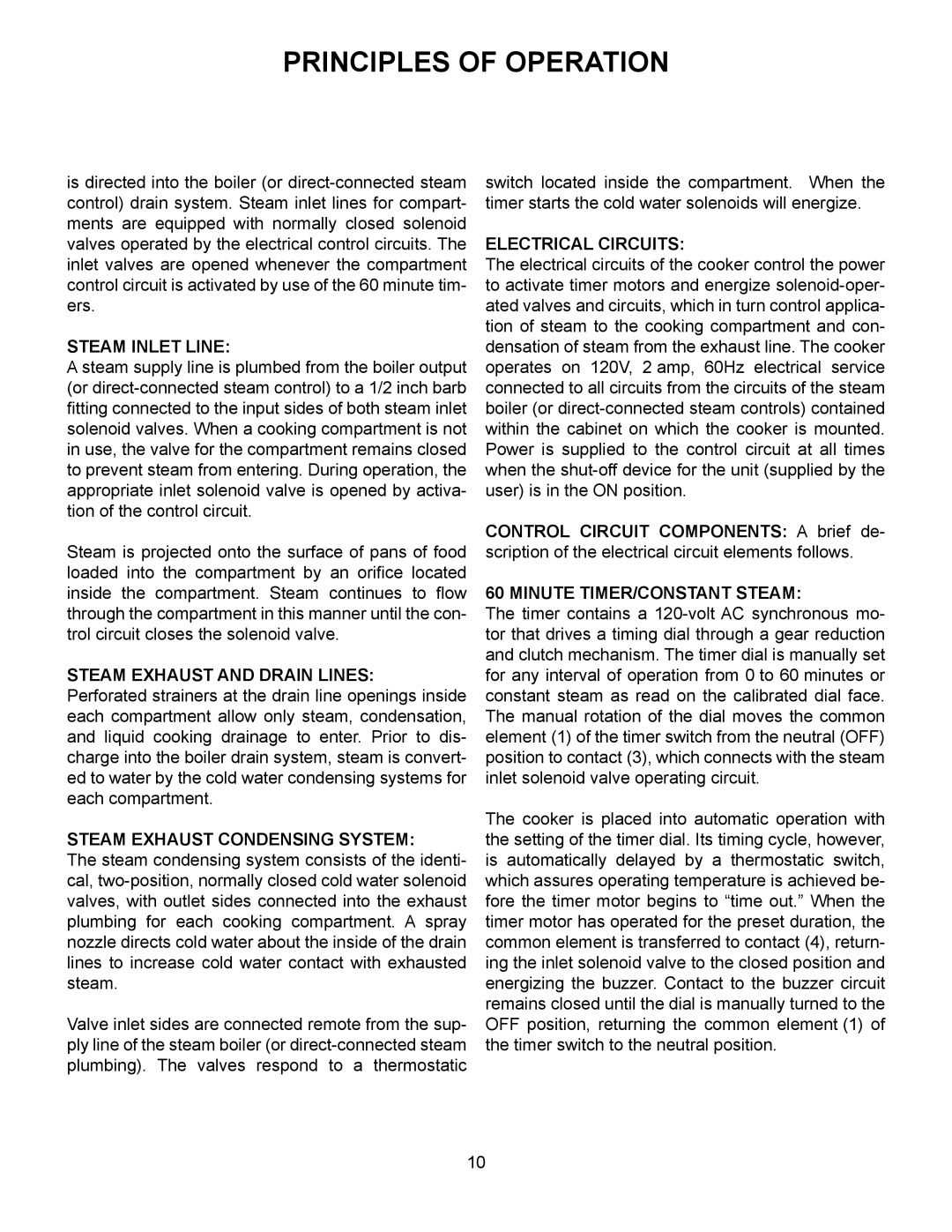is directed into the boiler (or direct-connected steam control) drain system. Steam inlet lines for compart- ments are equipped with normally closed solenoid valves operated by the electrical control circuits. The inlet valves are opened whenever the compartment control circuit is activated by use of the 60 minute tim- ers.
STEAM INLET LINE:
A steam supply line is plumbed from the boiler output (or direct-connected steam control) to a 1/2 inch barb fitting connected to the input sides of both steam inlet solenoid valves. When a cooking compartment is not in use, the valve for the compartment remains closed to prevent steam from entering. During operation, the appropriate inlet solenoid valve is opened by activa- tion of the control circuit.
Steam is projected onto the surface of pans of food loaded into the compartment by an orifice located inside the compartment. Steam continues to flow through the compartment in this manner until the con- trol circuit closes the solenoid valve.
STEAM EXHAUST AND DRAIN LINES:
Perforated strainers at the drain line openings inside each compartment allow only steam, condensation, and liquid cooking drainage to enter. Prior to dis- charge into the boiler drain system, steam is convert- ed to water by the cold water condensing systems for each compartment.
STEAM EXHAUST CONDENSING SYSTEM:
The steam condensing system consists of the identi- cal, two-position, normally closed cold water solenoid valves, with outlet sides connected into the exhaust plumbing for each cooking compartment. A spray nozzle directs cold water about the inside of the drain lines to increase cold water contact with exhausted steam.
Valve inlet sides are connected remote from the sup- ply line of the steam boiler (or direct-connected steam plumbing). The valves respond to a thermostatic
switch located inside the compartment. When the timer starts the cold water solenoids will energize.
ELECTRICAL CIRCUITS:
The electrical circuits of the cooker control the power to activate timer motors and energize solenoid-oper- ated valves and circuits, which in turn control applica- tion of steam to the cooking compartment and con- densation of steam from the exhaust line. The cooker operates on 120V, 2 amp, 60Hz electrical service connected to all circuits from the circuits of the steam boiler (or direct-connected steam controls) contained within the cabinet on which the cooker is mounted. Power is supplied to the control circuit at all times when the shut-off device for the unit (supplied by the user) is in the ON position.
CONTROL CIRCUIT COMPONENTS: A brief de- scription of the electrical circuit elements follows.
60 MINUTE TIMER/CONSTANT STEAM:
The timer contains a 120-volt AC synchronous mo- tor that drives a timing dial through a gear reduction and clutch mechanism. The timer dial is manually set for any interval of operation from 0 to 60 minutes or constant steam as read on the calibrated dial face. The manual rotation of the dial moves the common element (1) of the timer switch from the neutral (OFF) position to contact (3), which connects with the steam inlet solenoid valve operating circuit.
The cooker is placed into automatic operation with the setting of the timer dial. Its timing cycle, however, is automatically delayed by a thermostatic switch, which assures operating temperature is achieved be- fore the timer motor begins to “time out.” When the timer motor has operated for the preset duration, the common element is transferred to contact (4), return- ing the inlet solenoid valve to the closed position and energizing the buzzer. Contact to the buzzer circuit remains closed until the dial is manually turned to the OFF position, returning the common element (1) of the timer switch to the neutral position.
